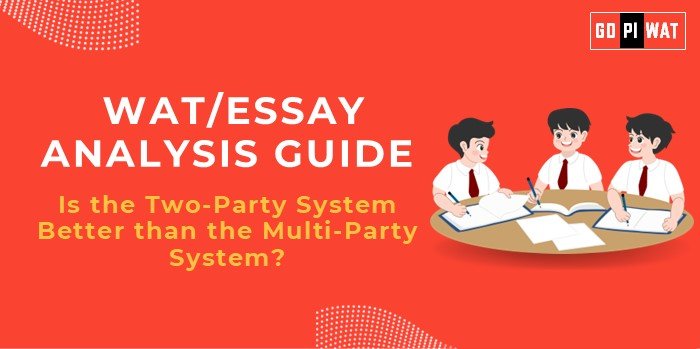🖋️ WAT/Essay Analysis Guide: Is the Two-Party System Better than the Multi-Party System?
🌟 Understanding the Topic’s Importance
The question of whether the two-party system is superior to the multi-party system is central to the study of democratic governance. It explores themes of political stability, representation, and policy effectiveness, crucial for understanding global politics and its socioeconomic implications. B-school applicants can leverage this essay to demonstrate analytical reasoning and an understanding of governance models.
📝 Effective Planning and Writing
- Time Allocation (30 minutes):
- ⏳ Planning: 5 minutes
- ✍️ Writing: 20 minutes
- 🔍 Review: 5 minutes
- Word Count Distribution:
- 📜 Introduction: 60–70 words
- 📖 Body: 350–375 words
- 📝 Conclusion: 60–70 words
📜 Essay: Is the Two-Party System Better than the Multi-Party System?
Introduction
Governance systems globally rely on political structures that often fall into two categories: two-party or multi-party systems. While the two-party system is lauded for providing stability and clear governance, the multi-party model is valued for its inclusivity and representation. This debate underscores a fundamental tension in democracies: balancing effective governance with the representation of diverse interests.
🔍 Achievements and Strengths
- Stability and Simplicity in the Two-Party System:The two-party system ensures decisive outcomes in elections, reducing the risk of prolonged coalition-building negotiations. For instance, the United States benefits from a streamlined electoral process, allowing governance transitions without significant delays. Voter choices are simplified, encouraging political participation.
- Inclusivity and Representation in Multi-Party Systems:Multi-party systems provide platforms for diverse voices, ensuring that minority groups and regional interests are not marginalized. India, the world’s largest democracy, epitomizes this approach. Over 2,500 registered parties allow voters to align with ideologies that resonate closely with their preferences. This inclusivity fosters engagement and reflects the democratic principle of representation.
⚖️ Challenges and Shortcomings
- Polarization in the Two-Party System:While the two-party system offers stability, it often leads to ideological polarization, stifling bipartisan collaboration. For example, the U.S. frequently faces legislative gridlocks during periods of divided government, such as the budget shutdowns seen in recent years.
- Instability in Multi-Party Systems:Conversely, multi-party systems are prone to coalition instability. Countries like Italy, with over 69 governments since 1945, exemplify the governance challenges posed by fragmented mandates. Frequent elections can disrupt long-term policy implementation and strain public resources.
🌍 Comparative Analysis
- Global Successes:
- ✔️ The United Kingdom’s two-party system fosters efficient governance through clear majorities in Parliament.
- ✔️ Germany’s multi-party model showcases how well-crafted coalitions can ensure stable governance and inclusive representation.
- Global Failures:
- ❌ The U.S. has seen increased dissatisfaction with its binary political structure, with 60% of voters feeling unrepresented by the two dominant parties.
- ❌ Israel’s multi-party system has led to repeated elections, illustrating the instability of fragile coalitions.
📈 Future Outlook
- 🔄 Reforms in Two-Party Systems: Introducing ranked-choice voting or proportional representation can address voter dissatisfaction by incorporating more diverse perspectives without undermining stability.
- ✔️ Coalition Management in Multi-Party Systems: Pre-election alliances and stricter anti-defection laws can enhance stability and governance. Germany’s coalition frameworks provide a model for balancing diversity and functionality.
💡 Conclusion
The debate between the two-party and multi-party systems boils down to the values a democracy prioritizes: stability or inclusivity. While no system is universally superior, hybrid approaches—such as ranked voting or structured coalitions—can combine the strengths of both. Democracies must evolve their governance models to address contemporary challenges, ensuring effective representation and policy implementation.
📚 Sample Short Essays
- Balanced Perspective:
“Both the two-party and multi-party systems aim to uphold democratic ideals but achieve them through distinct mechanisms. While the two-party model prioritizes stability, multi-party systems emphasize inclusivity. Countries must evaluate their socio-political contexts to determine the optimal approach, potentially integrating hybrid features like ranked-choice voting to address emerging challenges.”
- Solution-Oriented Approach:
“The choice between two-party and multi-party systems need not be binary. By adopting reforms like proportional representation or pre-election coalitions, democracies can achieve the best of both worlds: stability and inclusivity.”
- Global Comparison:
“Globally, the success of governance models varies by context. The UK’s two-party system excels in stability, while Germany’s multi-party coalition demonstrates inclusivity and functionality. Democracies should adapt these systems to their unique challenges, ensuring effective governance for all.”


